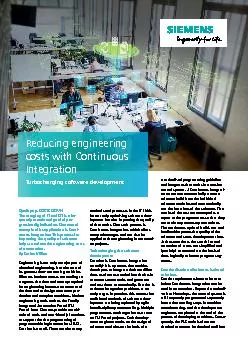

Quality up COSTS DOWNThe merging of IT and OT is a frequently mentioned goal of progressive digitalization One actual Reducing engineering costs with Continuous IntegrationTurbocharging software d ID: 846437
Download Pdf The PPT/PDF document "methods and processes in the IT fields f..." is the property of its rightful owner. Permission is granted to download and print the materials on this web site for personal, non-commercial use only, and to display it on your personal computer provided you do not modify the materials and that you retain all copyright notices contained in the materials. By downloading content from our website, you accept the terms of this agreement.
1 methods and processes in the IT fields f
methods and processes in the IT fields for not only optimizing software development but also improving the quality of the results. One such process is Continuous Integration, which offers many advantages and can also be applied to the engineering in automation projects.Turbocharging the softwaredevelopmentBut what is Continuous Integration actually? It is a process that enables developers to integrate their modifications as often as needed into the basic common source code, and generate and test them automatically. The aim is to detect integration problems at an early stage. In practice, this means that traditional methods of software development are being replaced by agile, interdisciplinary teamworking. Multiple programmers work together as a team on TIA Portal projects. Each development engineer works on the assigned software modules on the basis of a Quality up, COSTS DOWNThe merging of IT and OT is a frequently mentioned goal of pro-gressive digitalization. One actual Reducing engineering costs with Continuous IntegrationTurbocharging software development development phases of a machine. However, the later an error is detected, the more it costs to correct it. When several development engineers are working on a project, there is often a lack of transparency in the changes because there is a lack of necessary tools. And each development engineer likes to follow his own style in respect of naming convention, structure and the like. The evolution of software developmentAutomation engineering often lacks the prerequisites for test-driven developments, continuous software adaptations (refactoring), and quick code reviews. On the other hand, in IT, methods of agile software development have long been widespread and are used preferably if transparency and flexibility are needed to use the software quickly while maintaining high quality standards. Agile development concepts, as used in IT, can also be applied to automation: The use of powerful tools for version control and the standardization of software modules allows the versioning of the source codes to be used advantageously and efficiently. Version control is used to record changes to software objects and documents throughout the entire machine life cycle. All versions have a time stamp and user ID. The user can easily restore every version. The most important benefits of version control for automation engineers include the coordination of shared access for multiple developers to the objects, the transparency of changes, and the simultaneous working with multiple branches of the project development. Familiar examples of version control software are Git, Subversion (SVN) and Tfvc (TFS).Testing and reporting: a job for the jobThe source code in the version control system c
2 an now be used to create a testable buil
an now be used to create a testable build – a TIA Portal project with the essential software elements. The aim is to avoid generating test projects manually, but for the programmer to create a corresponding test case on the Continuous Integration server to automate their execution. This job starts the build on the automation PC and should also start the automated function test and check of programming rules. The job will then collect the logs and test results, analyze the exit codes, and make the results available to the programmer. The report contains the information required for detailed diagnostics, such as logs and data.TIA Portal as the center for Continuous IntegrationAs an engineering framework, TIA Portal contains an comprehensive library concept for supporting standardization and allow work flows to take place simultaneously. TIA Portal functions – such as Multiuser Engineering, Test Suite and Version Control Interface – provide answers to the stated requirements for achieving Continuous Integration. But technology by itself is not HerausgeberSiemens AG 2019Digital FactoryPostfach 4890026 Nürnberg, DeutschlandArtikel-Nr.: DFFA-B10476-00Änderungen und Irrtümer vorbehalten. Die Informationen in diesem Dokument enthalten lediglich allgemeine Beschreibungen bzw. Leistungsmerkmale, welche im konkreten Anwendungsfall nicht immer in der beschriebenen Form zutreffen bzw. welche sich durch Weiterentwicklung der Produkte ändern können. Die gewünschten Leistungsmerkmale sind nur dann verbindlich, wenn sie bei Vertragsschluss ausdrücklich vereinbart werden.enough. The company has to be prepared to make changes and bring together the separate disciplines so that mechanical, electrical and automation engineers can work together on a project simultaneously. The company‘s IT department must also be involved and provide the necessary servers and tools.In small steps to the digital transformation The benefits of Continuous Integration are obvious: The cycle of rapid changes and automated function tests reduces the risk of errors, improves the quality of the software, and creates a transparent development process. Automated sequences provide consistency and reduce the time required for engineering. Continuous Integration is one of many steps on the way to digital transformation. With standardization as the basis for digitalization, automation teams can already exploit a range of advantages and transfer their experience step by step into the entire company. This makes standardization the ideal starting point for progressively implementing a completely continuous development process. Building on this, Continuous Integration can be implemented step by step, and applied to both small and very extensive projects